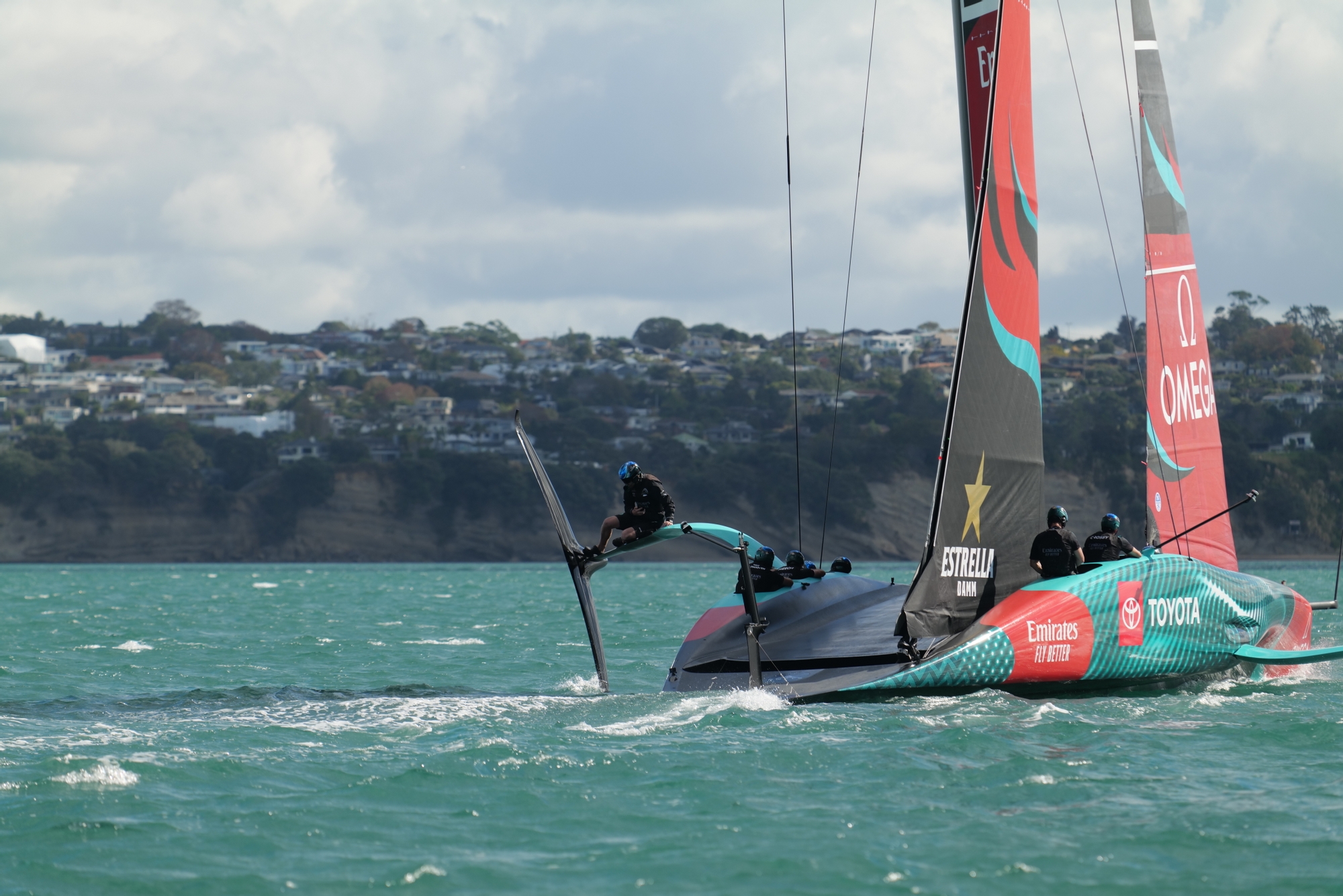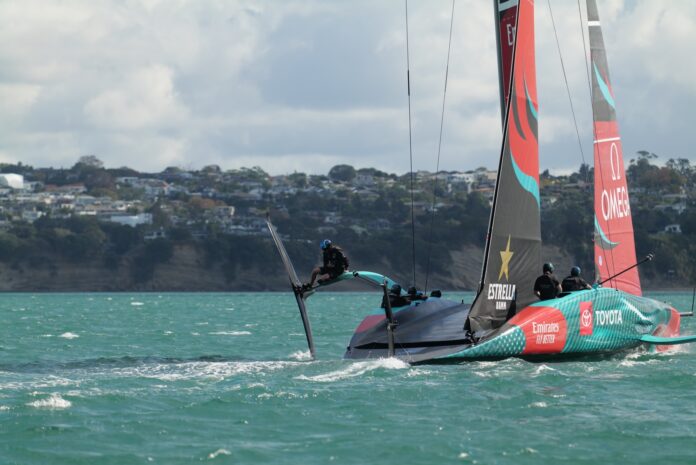The over-riding take-away from the early commissioning phase of the new Emirates Team New Zealand AC75 is one of smoothness personified. As the sailing team wind up through the commissioning gears – and even with legacy foils – what we’re seeing is a boat flying at a consistency both in a straight-line and through the manoeuvres with an ease of purpose and simplified execution.
The almost unseen power unit is delivering from the aft pods what looks like plenty of control and already we’re seeing sail shape manipulation, perhaps through early pre-sets, that makes boat-handling look a cinch. Going from downwind into fast round-ups, the Kiwis play their calling card of making the one-board turn seem routine with the mainsail powered down to a flat board from an open leech and the jib coming on efficiently. Upwind, it’s all about the end plating with the middle third working hardest, hunkering the boat down and anchoring it to the water’s surface with a deftness of bustle skimming.

On a day where the breeze in the Auckland Bays just bult deliciously from 8 to 18 knots, it gave the sailors the perfect opportunity to rifle through the new sail inventory and only a jib halyard lashing failure marred an otherwise flawless training session of the highest intensity so far over five hours. Already the team are into windward/leeward laps and pre-starts, pushing on hard with the training and barely missing a beat from the days of Te Rehutai. Impressive work from the Kiwis all round.

Speaking afterwards, Blair Tuke, spoke about the learning curve the team have been on with the new boat saying: “Pretty steep as expected, we’re lucky as a group we’ve been through these commissioning phases quite a few times now and we know what to prioritise through those early days and slowly but steadily we’re starting to get a feel for the boat, systems and new sails, it’s all coming together well so and obviously for us, the crew, new reference points and all little looks a bit different but yeah it’s going well.”

And he continued: “The boat’s going as expected, there’s always teething issues and things we’re trying to work through in the first few days but the team’s done an amazing job, it’s coming together really nicely and obviously we’re on the old foils still so that’s a consistent we know, but the rest of the boat’s going really nicely.”

Development is now key and Blair, knows better than most how demanding the next few months are going to be, saying: “We had an awesome platform with ‘Te Rehutai’ and what we call ‘Boat 2.5’ so that was pretty invaluable for us for all of those systems. The guys have really just slotted back into that and for us it’s more like back to that boat obviously than the AC40 with some things, so yeah that’s been really great to get them (the cyclors) back on the water and full steam ahead for the next six months.”

Talking about the jib halyard failure, Blair shrugged it off despite any failure at these speeds being somewhat scary, saying: “Just a minor mishap, we’ll have to check who’s lashing it was or what the exact fail was there but yeah little issue but no other damage from that which was good and managed to just put the same jib back up after we fixed that, but certainly when it goes bang when you’re going upwind at that sort of speed with a lot of power over the sail, it starts flapping pretty hard but got it under control pretty quick and carried on.”

Great session again from the defenders of the Louis Vuitton 37th America’s Cup who have now completed their fourth day of training on the new boat – and it hasn’t even been christened yet. (Magnus Wheatley)
On-Water Recon Report – Emirates Team New Zealand: Day 4 with ETNZ AC75 Boat 3 on the Hauraki Gulf saw a range of conditions that the team took full advantage of. Docking out at 10:30 am after a standard rigging process this morning, the team towed down the harbour heading to the lee of North Head to hoist the M2 and J2 sails. Starting their sailing session at around 11:15, the team sailed down the harbour to the south of Rangitoto Island and started heading for the ‘Back Paddock.’ However, as they made their way there, the breeze died off resulting in the team coming to a stop from no longer being able to foil.
After a quick turnaround, the team sailed back up the harbour for about 10 minutes and then proceeded to stop sailing again back in the inner harbour. This stop was to allow the team to change to the J4 as on this side of the harbour the wind had filled in completely and was now around the 12-knot mark. Spending roughly 15 minutes changing jibs, the team got back into sailing, now choosing to head out the Northern Channel and sail up the northern beaches.

While sailing along on port tack on a slightly lower to VMG upwind mode, the recon noticed a drastic change in the boat’s performance, and the Jib luff tension went instantly slack. This was caused by a broken jib halyard, which looked to have broken just above the jib’s head. With Chase 1 alongside, the team quickly got into fixing the issue and hoisted the same jib with no further signs of concern. Starting sailing again approximately 30 minutes later.
Now sailing out of the northern channel and heading towards Tiritiri Matangi Island, the team spent some time working on longer port and starboard gybes in the building breeze and sea state. Recon struggled to keep up. Completing a longer windward leeward lap and then a lap around the local youth regatta fleet, the team continued downwind for some time. The team stopped at 13:24 for a grinder swap and drinks break. During this stop, the call was made to change down to the J5 Jib, and with the building breeze, seemed like the correct call.
After this stop, the team sailed back upwind towards Takapuna Beach and then completed a couple of tighter windward leeward laps in the flatter water near the northern beaches. After a fast round-up into a tack, the team slowed the boat off the foils, and a crew member could be observed having a look over the port foil and foil arm. This went on for roughly 5 minutes. Starting sailing again with no continuing signs of concern, the team started into two practice starts using virtual marks and completing a windward leeward lap after each. Ending the session by sailing back up to the lee of North Head to drop sails and call it a day at 14:30.






